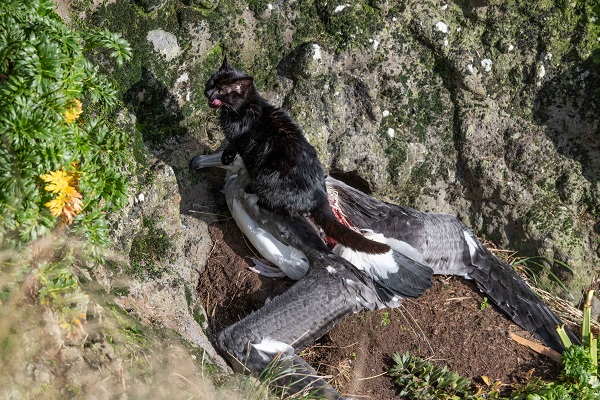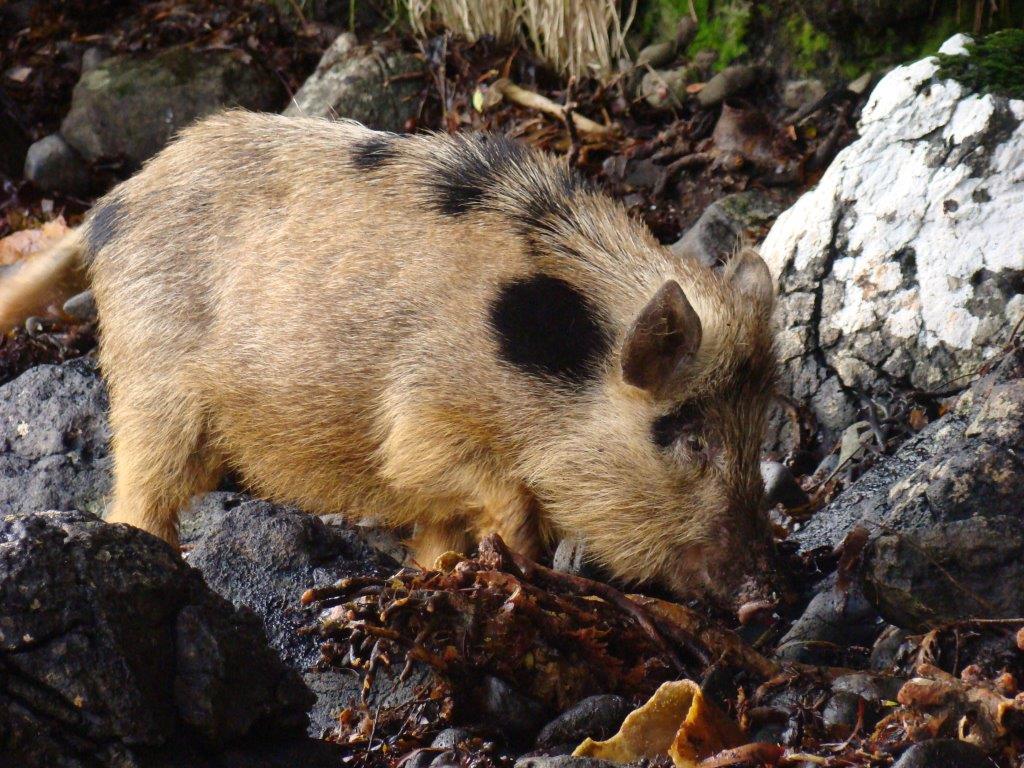
Licking its lips. A feral cat feeds on the corpse of a White-capped Albatross chick on Auckland Island, photograph by Stephen Bradley
South Africa’s Marion is not the only island in the Southern Ocean with plans to eradicate its House Mice. Over in New Zealand the Department of Conservation Te Papa Atawhai (DOC) has this month published a feasibility study to rid Auckland Island, the country’s largest sub-Antarctic land mass, of its predatory feral cats and pigs and House Mice.
“Following the successful eradication of mice from Antipodes Island, DOC and Ngāi Tahu have completed an investigation into the feasibility of eradicating pigs, cats and mice from Auckland Island in the New Zealand subantarctic region. The Maukahuka project hopes to make the island pest-free. This would enable 514+ species to thrive with over 46 000 ha additional protected habitat.”

A feral pig foraging among washed-up kelp fronds on Auckland Island, photograph by Pete McClelland
South Africa eradicated Marion’s cats that killed many burrowing petrels several decades ago, and fortunately pigs introduced to the island by sealers in the early 19th century were soon all hunted out, leaving only the mouse as the island’s sole introduced mammalian predator. Seems then that the New Zealand experience can materially inform the Mouse-Free Marion Project. Already several island eradication experts based in New Zealand are members of MFM’s Scientific and Technical Advisory Group (STAG). And of course, New Zealander (and vastly experienced) Keith Springer joins the project as its Operations Manager next month – such international collaboration augers well for a successful eradication on Marion Island come 2013.
The Context and Conclusion sections from the feasibility report’s 13-page Executive Summary follow:
“Context
A project has been proposed to eradicate pigs, mice and cats from Auckland Island, the main island of the Auckland Islands in the New Zealand subantarctic islands area (NZSIA). The project is known as Maukahuka Pest Free Auckland Island. This report, completed by New Zealand’s Department of Conservation (DOC), provides a feasibility study of the project.
The purpose of a feasibility study is to understand the costs, benefits, risks and technical challenges of a project and allow informed decisions on the project design to give it the best chance of success. It also allows a project with a high chance of failure to be ‘shelved’ before large sums of money are committed. Feasibility studies are a standard part of DOC’s eradication best practice.
In this report we assess more than 3 year’s work to understand the feasibility of eradicating pigs (Sus scrofa), mice (Mus musculus) and feral cats (Felis catus) from Auckland Island. The report addresses three key questions: why do it, can it be done and what will it take? It also provides a reference and justification for stakeholders, outlines methodologies for the eradication of each of the target pest species, identifies the scale of the undertaking so it can be considered and resourced appropriately, and highlights the next steps needed for quality project design. Findings from the work to date are addressed in detail in this document to inform project planning. We used an evidence-based approach and expert elicitation, including extensive field trials to reduce uncertainty and test methods. DOC’s Island Eradication Advisory Group (IEAG) and several other experts have provided technical advice and review.
Conclusion
Eradication of pigs, mice and cats from Auckland Island is worthwhile, achievable and sustainable. Maukahuka is a priority eradication project because of its special protection status and the severity of damage from mammalian pests to this taonga. The project is complex with a long timeframe and the scale is significantly increased by the lack of pre-existing infrastructure and remoteness. However, the challenges can be planned for and overcome. The large investment is spread over the life of the project and well protected by the isolation of the site as the risk of pests returning is low. It is the largest island eradication objective for PF2050 [Predator Free 2050 Ltd] that is well defined and ready to progress. It offers an attractive opportunity for partnerships and for tangible large-scale outcomes in the medium term to create momentum and advance New Zealand’s PF2050 goal.
Several risks require high-level attention during project design and are critical to success. Consideration of these can start early in anticipation of project initiation. Steps that can be taken immediately include initiating/continuing development of required capabilities, progressing permissions, completion of site management plans, securing funding and completing project design. These actions will aid in minimising the lag between a decision being made to proceed and achieving the readiness required to commence implementation. To make progress, a decision to proceed and a committed investment strategy are the highest priority next steps, which would allow critical path tasks to commence.
Maukahuka is a wonderful example of the ambitious approach that DOC has demonstrated in its history of acting to protect and undo damage in our most treasured but challenging places. The feasibility of this project carefully builds on the lessons from the past; we stand on the shoulders of giants. Armed with this knowledge, the wero of kaitiakitanga has been laid down to restore the mana of Auckland Island.”
The Maukahuka Project is now ‘on hold’ indefinitely due to issues related to the COVID-19 pandemic and budgetary constraints (click here and here). Nevertheless, the detailed feasibility report for Auckland Island will surely help guide similar studies elsewhere.
With thanks to Keith Springer.
Reference:
Department of Conservation 2021. Technical Feasibility Study Report for Eradication of Pigs, Mice and Cats from Auckland Island.. Invercargill: Department of Conservation Te Papa Atawhai. 123 pp.A 15-page summary version of the feasibility study is also available.
John Cooper, ACAP Information Officer, 11 June 2021

 Français
Français  English
English  Español
Español